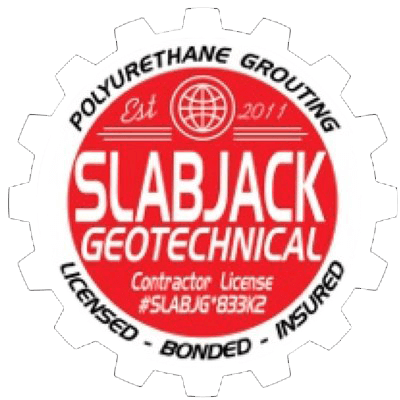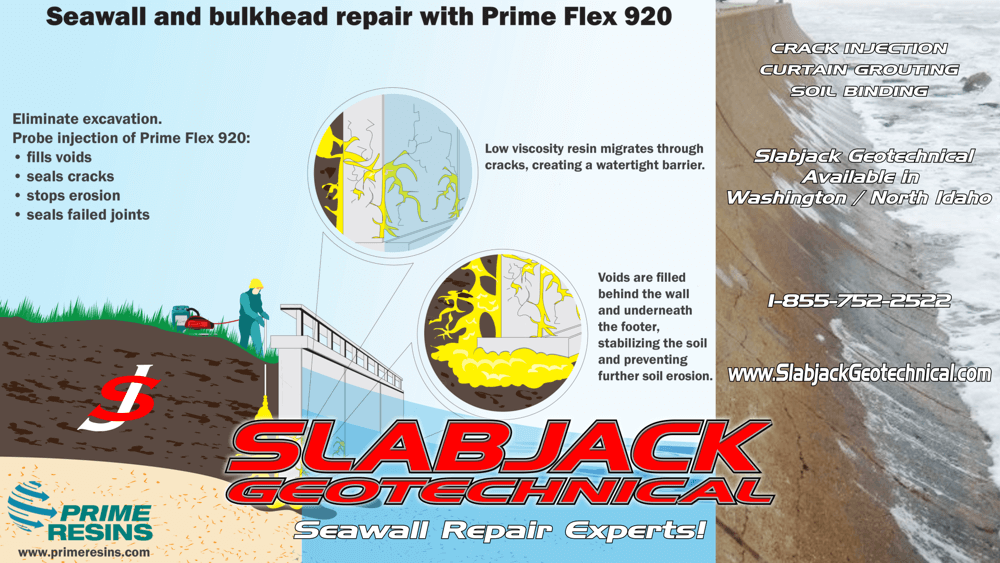Local & Affordable – Seawall Concrete Repairs
In need of an experienced and reliable team for a seawall repair? Slabjack Geotechnical provides masonry and seawall concrete repair services across Washington and Northern Idaho.
We can seal leaks in concrete or masonry with crack injections and curtain grouting of our hydrophobic polyurethane. We offer quality masonry and seawall erosion repair solutions for stopping leaks in any type of environment. Our service helps limit or eliminate soil loss and settlement that occurs behind your seawall or bulkhead.
Signs You May Need a Seawall Repair
Seawall repairs can be expensive and should not be taken lightly. If your structure is showing signs of deterioration, it’s important to take action sooner rather than later.
Signs that you may need a seawall repair include:
1. Visible cracks in the seawall – Cracks or separation along the length of the wall can weaken its structural integrity and cause further damage over time if left unchecked.
2. Doors and windows near the seawall that won’t open/close properly – The weight of water pushing against the seam between your walls and doors/windows can eventually cause them to not open or close properly, resulting in water seepage into your property.
3. Unusual water stains on the surface of your seawall – This can be a sign that water is getting past the wall and into your property, which could result in costly damage if it’s not addressed.
4. Erosion or crumbling around the base of the structure – If soil and other materials are eroding away, it can cause weakening of the foundation and further damage to your seawall.
If you’re noticing any of these signs, then it’s important to contact a professional for an assessment to determine whether you need a repair. Seawalls should be checked annually to ensure they remain structurally sound, so don’t put off making necessary repairs!
Signs You May Need a Bulkhead Repair
A bulkhead is an important structural component of many homes and buildings, so it’s essential to keep it in good condition. If you suspect that your bulkhead may need repair, there are certain signs you should look out for.
1. Visible signs of rust or corrosion – Rust or corrosion are the most visible and common signs that you need a bulkhead repair. If you notice any spots of rust or corroded areas, it is best to contact a professional for a thorough inspection.
2. Leaks in your basement – Another major sign that you need a bulkhead repair is if there’s any water seepage coming from the walls or floors of your basement. This could signify that your bulkhead has been damaged by moisture and needs to be repaired as soon as possible to avoid further damage to your foundation and property.
3. Musty smells – A musty smell in your basement could be an indication of water damage, which could lead to the need for a bulkhead repair. If you notice any strange smells, it is important to take action immediately.
4. Cracks in your walls – Cracks in your basement walls may be signs of structural damage that needs to be addressed with a bulkhead repair. It’s important to have a professional inspect the area and determine if this is an issue or not.
5. Doors or windows sticking – If you find that your doors and windows are sticking, it could mean that there is too much water or moisture around the frame of the door or window, which could be caused by a damaged bulkhead system. A bulkhead repair can help fix this problem and ensure you don’t experience any further issues.
If you’re experiencing any of the signs mentioned above, it is important to contact a professional and get your bulkhead system inspected right away. A bulkhead repair can save you thousands of dollars in the long run by preventing future damage.
How Do We Repair Seawalls and Bulkheads?
Our seawall concrete repair specialists start off by injecting polymer into the voids that are present. The polymer then spreads out and fills the void without causing any damage to the seawall or bulkhead. The polymer causes any water that is present to be pushed out. This process may also help you avoid replacing your bulkhead entirely, which can be a costly expense. There is also a chance that repairing your seawall will level or raise your concrete to the correct point.
Built to Last
With over 25 years of experience in this field and a commitment to reliable results, our customers know that their project will be completed to the highest standards possible. By using specialized equipment and methods such as compaction grouting, slabjacking, pressure grouting, and more, we can ensure that your seawall or bulkhead is stabilized for years to come. We use top-of-the-line materials when constructing our repairs so you can rest assured knowing your repair will withstand the test of time. In addition to strength, our repairs also last longer than most other methods due to proper construction techniques and high-quality materials, providing you with peace of mind that your repair will be done correctly.
We understand the importance of reliable seawall and bulkhead repairs for safety and preservation purposes. That is why we strive to provide our customers with a product that is both strong and durable. By utilizing state-of-the-art technology and equipment, combined with years of experience in this field, we deliver results that are sure to last. Our commitment to quality ensures that you get a lasting solution, so you can rest easy knowing your investment was well worth it.
Why Choose Slabjack Geotechnical?
Slabjack Geotechnical is the leading seawall and bulkhead repair company using polyurethane injection as its primary method. Occasionally our method is not well-suited to the issue found during an inspection. Fortunately, we have cultivated relationships with several highly rated companies with other methods and processes for seawall and bulkhead repair which we can recommend. Our company is fully licensed bonded and insured.
If you require our seawall concrete repairs expertise, we invite you to contact us at your convenience. To find out more information about our seawall repair services, call us at 1-855-752-2522, send an email to info@SlabjackGeotechnical.com, or read our blog. We look forward to fixing your seawall and preventing further damage! We proudly service all of the Washington and Northern Idaho area.
Contact Us
FAQs
The best way to fix erosion behind a seawall is to install additional protective measures. This can include large rocks or boulders at the base of the wall, which act as armor against wave action. It can also include adding additional layers of protection such as riprap, geo-textile mats, or even concrete revetment blocks.
Reinforcing a seawall typically involves increasing its durability or strength. This can be done through the use of various materials, such as steel-reinforced concrete, timber, stone, or plastic piles. Steel-reinforced concrete is often used to replace existing sections of weakened seawalls and helps reduce wave action and water erosion.
In some cases, timber may be used to strengthen a seawall, as it provides flexibility and strength. Stone or plastic piles can be installed along the length of the seawall to provide additional support and reduce wave energy.
Other techniques such as strengthening existing structures, geotextile, slope stabilization, surface drainage systems and submerged breakwaters may also be employed to reinforce a seawall. Additionally, regular maintenance and inspections should be carried out to ensure the seawall’s structural integrity.
Backfill material for the construction of seawalls should be chosen based on the desired performance, site conditions, and cost. Generally, sandy soils or gravels with low organic content and free from deleterious materials are best suited for backfill applications. These materials should have an effective size range between 0.5 and 2 mm, a uniformity coefficient between 1.5 and 3, a permeability of at least 1 x 10-4 cm/sec, and an Atterberg limit of 15%.
Coarse sand with gravel also works well in backfill applications as it provides adequate drainage. Gravels should have a maximum size of 10mm and should not be composed of any organic material. In addition, the gravel should be free from any salt deposits or mud.
In certain cases, it may also be beneficial to use geotextile fabric as backfill material in seawalls. This can help reduce the risk of soil erosion and water infiltration while providing adequate drainage for the wall. However, this type of material can be expensive and should only be used when absolutely necessary.
The lifespan of a seawall varies greatly depending on the materials used for construction and the level of maintenance it receives. For example, concrete seawalls can last up to 40 years with proper upkeep, while steel sheet piling or timber bulkheads may only last 10-15 years. Regular inspections and maintenance are essential to ensure that your seawall is in good condition and able to withstand the test of time. Additionally, any damages sustained by the seawall should be addressed as soon as possible in order to avoid further deterioration or catastrophic failure. By following a regular maintenance schedule and being proactive about addressing necessary repairs, you can ensure that your seawall will offer long-term protection for your property.















